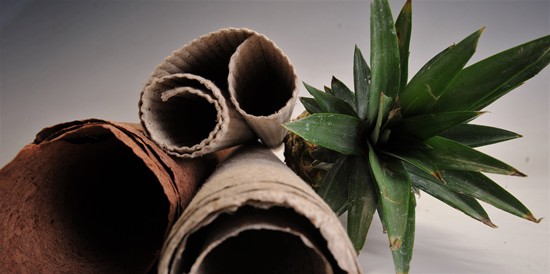Save the Children
Philippines steps up assistance to displaced children in
earthquake-hit areas in Mindanao
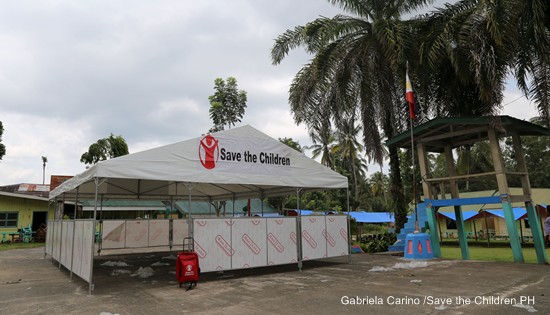
Press Release
November 13, 2019
MANILA – Save the
Children Philippines has delivered family hygiene kits and plastic
tarpaulins to ease the suffering of children and their families
affected by the series of strong earthquakes in Mindanao.
A total of 1,051 family
hygiene kits and 130 plastic tarpaulins have been distributed to
children and their families in the most affected towns of Makilala
and Magpet in North Cotabato to protect them from contagious
diseases while in cramped evacuation centers and while temporary
taking shelter in makeshift tents outside their damaged houses.
The humanitarian team of
Save the Children Philippines will set up temporary learning spaces
and distribute teaching kits starting this week to ensure displaced
learners can resume classes.
Lawyer Alberto Muyot,
chief executive officer of Save the Children Philippines said the
resumption of classes is critical to address psychosocial stress of
affected children because it re-establishes their routines.
“Keeping children safe
inside learning spaces is critical in times of emergencies. Children
know that education gives them power to build a better future,” said
Muyot in a statement.
Initial figures from the
Department of Education (DepEd) showed that some 3.2 million
school-age children have been affected by the series of earthquakes
that hit four regions in Mindanao including the war-torn Bangsamoro
Autonomous Region in Muslim Mindanao (BARMM) as well as Davao and
SOCCSKSARGEN regions. Out of the 3.2 million children, at least 1.6
million of them are in Davao, SOCCSKSARGEN, and BARMM, regions that
were affected by the earthquake.
Jerome Balinton,
humanitarian manager of Save the Children Philippines, said the
three temblors have caused massive destruction and damage to houses,
schools, roads and infrastructure and it may take years to complete
rehabilitation of the damaged infrastructure. Latest report from
DepEd as of Nov. 11 also show that 1,046 classrooms were totally
damaged, while some 1,274 classrooms sustained major damage.
“But children cannot wait.
The need for psychosocial support, shelter, water, hygiene and
sanitation and the resumption of classes in safe learning
environments is immediate and crucial to the recovery of children
and their families,” said Balinton.
At the moment, more than
11,000 families remain in evacuation centers, with limited access to
water and sanitation facilities. And with many schools being used as
evacuation centers, children’s learning is also affected. DepEd
report also shows that there are 41 schools used as evacuation
centers.
A total of 260,492 people
were affected by the three strong earthquakes across Mindanao, with
24 dead. Of the affected population, over 103,000 individuals are in
Makilala town.
“The numbers are expected
to escalate as most of the affected families live in hard to reach
areas,” said Balinton.
|
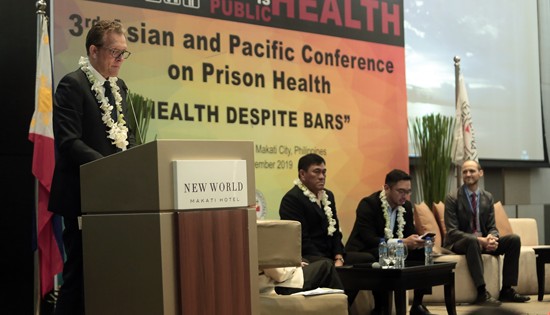
“To
break the cycle of poor health outcomes in prisons, we need
to go beyond curative care and examine the inmates’ living
conditions. We must look at prison health care from all
angles. We must consider prison health as a public health
issue if we are to break that cycle,” said ICRC Head of
Delegation Boris Michel in his opening remarks. In photo are
(from left) Philippine Interior and Local Government
Undersecretary Nestor Quinsay, Philippine Justice
Undersecretary Deo Marco, and Thomas Hiatt, technical
officer of the World Health Organization. |
Health despite
bars: Asia-Pacific region tackles state of prison health
By
ICRC
November 13, 2019
MANILA – With the
Asia and Pacific region having over four million prisoners – the
highest in the world according to the latest World Prison Population
List – tackling the need for quality healthcare among detainees is
as complex as it is critical.
“Prisoners deserve the
same standards of healthcare as are available to the community, as
well as access to health services without discrimination. But often,
the inmates’ health needs cannot be fully met due to challenges in
the coordination among authorities concerned, lack of coherence in
policies and procedures, inadequate health staff and facilities,
among other reasons,” said Dr. Ziad Tohme, who works with the
International Committee of the Red Cross (ICRC) as a regional
specialist looking into the health-care needs in detention
facilities in Asia and the Pacific.
Poor living conditions in
many prisons across the world adversely impacts the health of
inmates, worsening their pre-existing ailments or leading to new
health concerns in prisons.
“Tuberculosis and other
communicable diseases are significantly prevalent in prisons, and
may spread to the community through staff, visitors and released
prisoners who received inadequate treatment. Curative care must be
supported by improving food and nutrition, water, sanitation and
having activities for better health. It’s also critical to recognize
that prison managers and other staff are just as responsible for
prisoners’ health,” Dr. Tohme said.
To support authorities in
the region strengthen their prison health systems for the benefit of
inmates, jail staff and communities at large, the ICRC organized the
third Asian and Pacific Conference on Prison Health (APCPH) from 13
to 15 November 2019 in Manila, Philippines.
Titled “Health Despite
Bars”, the conference provides a platform to health and detention
authorities, academics and public health experts, to share research
and best practices, as well as challenges. The conference also aims
to:
- promote a
whole-of-government approach to prison health;
- increase awareness of
international standards;
- encourage participants
to be active members of the worldwide prison health research and
engagement network.
Around 150 participants
involved in prison health from 21 countries will discuss topics such
as health needs of women and other vulnerable groups, mental health
and drug addiction, international standards for prison health.
As a result of the
conference, it is hoped that the participants will help improve the
health outcomes of detainees through effective management and
coordination, promote respect for fundamental rights protecting all
detainees, and implement related standards and principles (including
“equivalence of care”), contributing to a healthier society.
“We’re all involved in
providing care to people in custody. Coming to a conference allows
us to find out what’s working in some places, what’s not working so
well… share our experiences. The reason why we’re all here is to
improve care for people who are in detention. We are all passionate
about that and so if we can learn from each other that can improve
the care of people in custody, that’s a great thing,” said
participant Fiona Montroy, clinical nurse consultant of Justice
Health and Forensic Mental Health Network in New South Wales,
Australia.
|
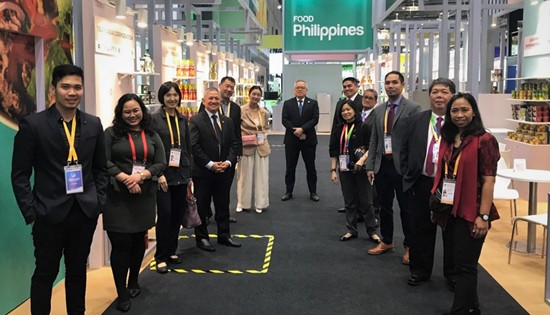
Secretary
Ramon M. Lopez led the Philippine delegation to the second
edition of the China International Import Expo. In the Photo
DTI Secretary Ramon M. Lopez (center) from right of center,
DTI-Trade Promotions Group Undersecretary Abdulgani
Macatoman, Assistant Director Angelo Salvador Benedictos of
the Bureau of International Trade Relations, Assistant
Director Agnes Perpetua Legaspi of the DTI-Export Marketing
Bureau, Commercial Vice Consul Mario Tani of PTIC-Shanghai,
Commercial Vice Consul John Paul Inigo of PTIC-Guangzhou, Ms
Rowena Mendoza of CITEM, from left of center, Executive
Director Paulina Suaco-Juan of CITEM, Mr Jimmy Tang of Team
Asia Corporation, Commercial Counsellor Glenn Penaranda of
PTIC-Beijing, Tropicana Food Corporation Representative, Ms
Michelle Pontilas of Bureau of International Trade Relations
and Mr Rudolph Velasco of DTI-Export Marketing Bureau. |
PH sales at
Chinese expo more than double at US$300 million
By
DTI-TPG-EMB
November 13, 2019
SHANGHAI, China –
Philippine (PH) exhibitors booked around US$300 million in sales at
the 2nd China International Import Exposition (CIIE), more than
twice the US$124 million recorded sales last year. Top sellers were
fresh bananas, pineapples, mangoes and durian; not to be outdone
were processed fruits and nuts, and other coconut-based products.
“The big jump in sales
since the last CIIE proves that the China sees the Philippines as a
significant source of agricultural and other products. This
motivates us to continue our efforts in getting more exhibitors to
the CIIE, as well as improving trade relations and market access
through the conclusion of the Regional Comprehensive Economic
Partnership (RCEP). Suppliers, on their part, should increase their
production to answer the demand of the Chinese market,” said
Department of Trade and Industry (DTI) Secretary Ramon Lopez.
Sec. Lopez led a
139-strong Philippine delegation, with 32 food exhibitors
participating this year. With the huge opportunity in the Chinese
food market, Sec. Lopez has advocated for continued, stronger and
effective presence in the CIIE through strategic positioning of
Philippine products to serve the upgraded requirements of Chinese
consumers.
Since it began last year,
the CIIE 2019 is a trade fair held in autumn in Shanghai and is the
world’s first import-themed national-level expo. The total
exhibition area of the CIIE exceeds 240,000 square meters and
attracts an average of 150,000 professional buyers, with more than
100 participating countries. Amidst these immense numbers,
Philippine products – known to be of quality to foreign buyers –
received overwhelming approval at the CIIE.
Many Chinese buyers and
consumers lined up to try the various food products offered at the
Philippine Food Pavilion consisting of 32 exhibitors, including
premium tuna products recently launched in the Chinese market by
Century Pacific and other products by Philippine global brands such
as San Miguel, Monde Nissin, and Fisher Farms.
Chef Bea Nitard of Via
Mare used Philippine ingredients to prepare dishes suitable to the
Chinese palate. The chef observed that the Chinese are not afraid to
try new things and the Philippines should introduce more premium
food products to the Chinese consumers. The popularity of the dishes
was apparent in the long lines seen at the Food Philippines Pavilion
every day.
The Philippine pavilion
was formally opened by the DTI Undersecretary Abdulgani Macatoman,
with China's Ministry of Commerce Director General Peng Gang. In his
opening remarks, Undersecretary Macatoman highlighted the role of
the 32 Philippine exhibitors in contributing to the growth of
Philippine exports in China's food sector, especially in the fresh
fruits category. The Philippines currently exports mangoes, bananas,
papayas, pineapples, and young coconuts. But Undersecretary
Macatamon observed that with the stronger Philippine-China relations
and through China’s liberalization program and the CIIE, there will
be more Philippine food products sold in China soon.
The Philippine
participation was organized by DTI through the Center for
International Trade Expositions and Missions (CITEM). It was
supported by the Export Marketing Bureau (EMB) and the Foreign Trade
Service Corp (FTSC) through the Philippine Trade and Investment
Centers (PTICs) in Shanghai, Beijing, and Guangzhou in partnership
with the Department of Agriculture (DA), the Agribusiness and
Marketing Assistance Service (AMAS), and the Office of the
Agricultural Counsellor in Beijing.
With the positive feedback
and results generated from the Philippine participating companies
and keen interest shown by Chinese buyers, DTI and DA expect a much
bigger participation in the next edition of the CIIE in 2020.
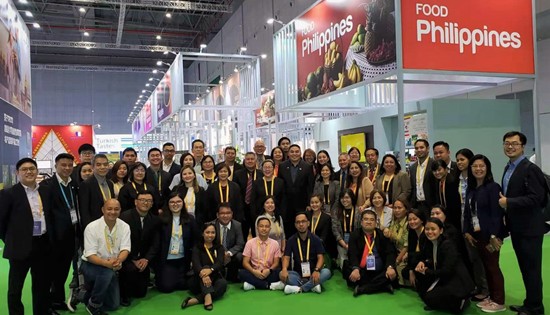
|

Winners
of the 25th PSQ Regional Finals (L-R): Mr. Ben Julian M.
Merales, Mr. Adonis Rancie G. Handog and Mr. Filbert M.
Abalon. |
UPVTC’s Comp Sci
student is the 25th PSQ regional champ!
By
PSA-8
November 13, 2019
TACLOBAN CITY – Mr.
Ben Julian M. Merales, BS Computer Science student of the University
of the Philippines -Visayas Tacloban College (UPVTC), won the 25th
Philippine Statistics Quiz (PSQ) Regional Finals conducted on 12
November 2019 at Leyte Park Hotel, Tacloban City.
Mr. Merales emerged as
regional champion, besting 18 other contestants, after scoring 24
points in the three (3) rounds of questions and answers on
statistical theories and problems. Completing the top three (3) were
Mr. Adonis Rancie G. Handog of the Visayas State University Main
Campus - second place, and Mr. Filbert M. Abalon of the University
of Eastern Philippines - third place. Winners were given cash prize
of P15,000, P12,000 and P10,000, respectively, and certificate of
recognition. Likewise, respective winning coaches received cash
prize equivalent to half of their contestant’s prize aside from the
certificate of recognition from the PSQ organizers.
The PSQ is a nationwide
annual contest conducted by the Philippine Statistics Authority (PSA)
in partnership with the Philippine Statistical Association Inc. (PSAI),
in line with the National Statistics Month (NSM) Celebration. It is
designed to test the knowledge in statistics of freshmen students
enrolled in colleges and universities and to identify and nurture
talents especially in the field of statistics. It also aims to
contribute to the advocacy in the use of statistics for
evidence-based decision making. The results of the contest can also
provide indications of the effectiveness of the statistics component
of mathematics as a subject in the secondary curriculum.
The 25th PSQ Regional
Finals was conducted simultaneously with the 16 regions in the
country. Mr. Merales will represent Eastern Visayas to the 25th PSQ
National Finals which will be conducted on 29 November 2019 in Metro
Manila.
Stakeholders laud
DOLE’s SPES program
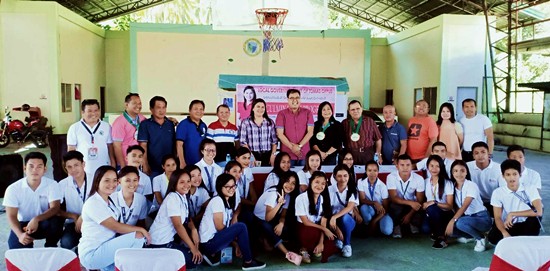
By
NORMA RAE S. COSTIMIANO
November 7, 2019
MAASIN CITY – The
students of Tomas Oppus, Southern Leyte lauded the DOLE’s Special
Program for Employment of Students (SPES) during the Culmination
Activity conducted by the Public Employment Service Office (PESO) of
the said local government unit on October 22, 2019.
Department of the Interior
and Local Government Undersecretary Epimaco V. Densing III graced
the program and delivered his inspirational message.
“With the DOLE’s SPES
program, I encourage you to value the opportunities being given by
government and gain from it ,” said Usec. Densing.
He likewise mentioned that
SPES is indeed a very good program which provides students
experiences before they actually immerse themselves in the world of
work.
One SPES beneficiary cited
her appreciation to the DOLE and the LGU led by Hon. Mayor Jessica
Marie Excaño Pano. She was thankful for the experiences she gained
as a SPES beneficiary which exposed her to the realities in the work
setting, enabling her to learn office procedures and meet people of
different orientations.
DOLE Southern Leyte Field
Office (SLFO) Chief Marites Z. Viñas congratulated the student who
have successfully completed their term and inspired them by
providing valuable labor market information which can assist them in
finding the right jobs.
“Aside from having the
education, you need to possess soft skills which are nowadays being
considered such as perseverance and time management. These are the
current demands of the management in terms of hiring employees, so
you must be a smart jobseeker,” Ms. Viñas said.
Mr. Peter Edmar Tambis,
PESO Manager of Tomas Oppus and an awardee himself during the Search
for the 2019 Best PESO, expressed his warmest thanks to DOLE. He
requested more funds for SPES implementation to cater for more
deserving students.
A total of P156,377.00 has
been released by DOLE-SLFO to thirty-nine (39) beneficiaries. Each
SPES beneficiary received P4,012.91 as DOLE’s counterpart together
with their certificates of completion.
SPES is DOLE’s employment
bridging program during summer or Christmas vacation that aims to
augment the family’s income of poor but deserving student,
our-of-school youth (OSY) or dependents of displaced or would be
displaced workers who intend to finish their education.
(with reports from Marites Z. Viñas)
|
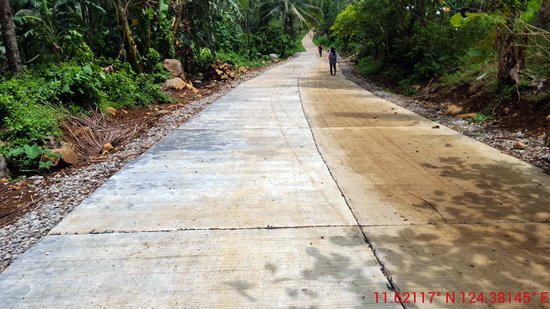
Completed
P1.94M construction /concreting of barangay road, Sitio
Ansay, Brgy. Union, Caibiran, Biliran under contract with
LJPM Builders and Construction Supply. |
DPWH-Biliran
DEO’s 2019 infra projects 61.14% done
By
DPWH-Biliran
November 7, 2019
NAVAL, Biliran –
The Department of Public Works and Highways (DPWH) -Biliran District
Engineering Office (DEO) achieved 61.14% accomplishment of its 2019
infrastructure projects as of October 31, 2019.
With only few months left
before the year ends, David P. Adongay Jr., District Engineer said
that they are rushing the completion of its on-going projects to
meet the district’s target accomplishment.
Out of the 92 projects for
2019 implementation, Biliran DEO has completed 39 while 43 are
on-going and 10 are Not-Yet-Started (NYS).
Adongay revealed that the
district office posts a negative slippage of 6.07% as of October 31,
2019.
“We have already discussed
this with the section chiefs and technical staffs and we are doing
immediate actions. Hindi pwede pabayaan lang natin na magdecrease
ang performance ng district kasi maaapektuhan ang future development
ng Biliran,” he said.
For 2019, DPWH-Biliran DEO
has a total allotment budget of P1.28B.
According to Adongay,
budget funding for next year will depend on the performance of the
district office in terms of its physical and financial
accomplishment.
“Less budget also means we
will be forced to terminate few of our job orders which plays a
vital role in our day to day operation,” he said.
Despite of the haste in
the implementation, Adongay ensures that quality of projects will
not be compromised.
Adongay reported that 15
infrastructure projects have already been completed this October.
These projects include the construction of P3.9M gymnasium at Brgy.
P.S. Eamiguel, P1.95M completion of Boy Scout of the Philippines (BSP)
building (Phase II) at Brgy. Larrazabal and P981,381.00 construction
(completion) of multi-purpose building at Higatangan, all in Naval
town.
DPWH-Biliran DEO has also
completed the improvement of plaza at Brgy. Bariis in Caibiran town
worth P969,350.00, renovation of fencing/ flooring plaza at Brgy.
Bacolod in Culaba town worth P969,920.00, completion of senior
citizen building at Brgy. Looc in Almeria town worth P945,400.00 and
improvement of access road leading to Kawayan port in Kawayan town
worth P12.356M.
Moreover, eight flood
mitigation projects have also been completed. These projects are
located along Bagongbong river in Almeria town (P18.99M), Santol
river in Biliran town (P24.850M) and Kaulangohan river (P14.43M) and
Binohangan river (P1.94M) both in Caibiran town.
Two flood control projects
are also completed along Mainit river (Phase 2) worth P14.2M under
Regular Infrastructure Program and P4.87M flood control at Sitio
Mainit, Brgy. Villa Vicenta under 2019 local infrastructure program,
both in Caibiran town.
Meanwhile, two flood
control structures have also been completed at Sitio Anas, Brgy.
Atipolo in Naval town worth P14.65M funded under regular
infrastructure program and P4.88M funded under local infrastructure
program.
Bugtong
Elementary School gets new 4-classroom building
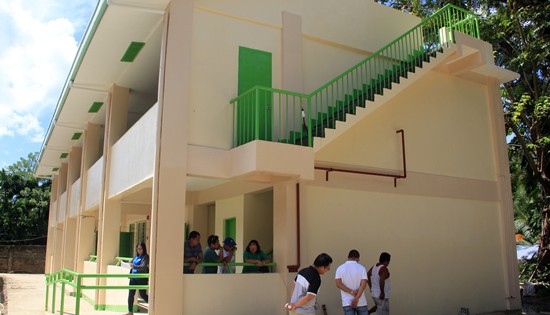
By
CHENZI MAY D. UY
November 6, 2019
CALBAYOG CITY –
Department of Public Works and Highways (DPWH) -Samar First District
Engineering Office (SFDEO) has completed the construction of a
two-storey, four-classroom school building in Bugtong Elementary
School, Calbayog City. The project drew a total of P12.2 million
from the Basic Educational Facilities Fund (BEFF) 2018.
For all 2018 school
building projects, DPWH adopted the updated standards and
specifications set by the Department of Education. This means the
new building now two roof-mounted water tanks and a fire
extinguisher in each room, in addition to the standard PWD ramp
access, sanitary comfort rooms, and fire alarms. One of the water
tanks will serve as a reservoir in case of fire, while the other is
for normal water usage within the building.
As per request by the
school head, DPWH introduced a volleyball court and a paved walkway
into the original design. It can be recalled that the school’s
volleyball team won Gold in the Calbayog City Wide Meet 2019 and
represented the city to the EVRAA Meet.
The provision of new
learning spaces primarily aims to decongest existing classrooms so
the ideal teacher-to-learner ratio can be achieved. This, in turn,
helps to improve the safety, comfort, and learning success of
students.
DPWH-Biliran DEO
acquires new equipment to accelerate road marking application
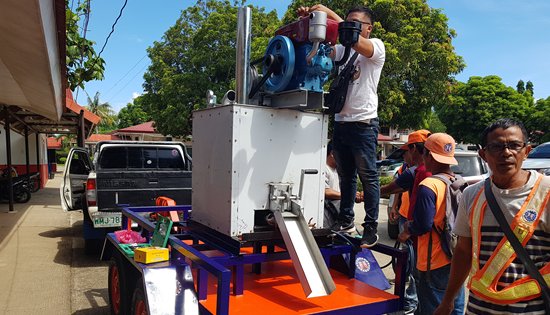
By
DPWH-Biliran
October 31, 2019
NAVAL, Biliran – A
thermoplastic paint pre-heater and paint applicator has been
acquired by Department of Public Works and Highways (DPWH) -Biliran
District Engineering Office (DEO) to accelerate work on road marking
application along Biliran’s national road network.
David P. Adongay Jr.,
District Engineer said that the procurement of these machines will
fast-track the work of maintenance personnel compared to the manual
road marking application.
“Using the machine, we can
really expect a more quality result with less manpower needed,” said
Adongay.
Road markings are applied
on paved roadways to provide guidance and information to drivers and
pedestrians to avoid road accidents. Road surface marking can also
indicate regulation for parking and stopping.
The newly acquired
equipment has a total cost of P2.18M funded through Engineering
Administrative Overhead (EAO).
DPWH-Biliran DEO regularly
conducts routine maintenance activities to provide quality service
to the public by implementing activities that maintains the quality,
safety and integrity of the roads, bridges and other structures
under their jurisdiction for the safety convenience of the traveling
public.
Design Center's
Pinyapel earns D&AD pencil
By
DTI-TPG-DCP
October 31, 2019
PASAY CITY – The
Philippine-made Pinyapel, a specialty paper made from discarded
pineapple leaves, bagged a Wood Pencil at the D&AD Future Impact
Awards 2019 in recognition of its potential to create a huge impact
on environment and sustainability as it is proposed to be a food
packaging alternative to single-plastic. The award will be presented
in New York City, USA on November 6. Industry professionals consider
the D&AD pencil as equivalent to “career knighthood”.
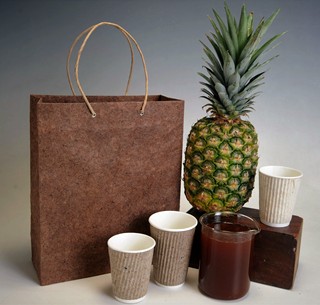 With this recognition of
Pinyapel, it will receive a D&AD Wood Pencil, a place on the D&AD
Future Impact Accelerator programme, especially designed to
accelerate Pinyapel’s development in order to deliver tangible
impact in their category area within 12 months. The D&AD Future
Impact Programme supports great ideas that have the potential to
change the world.
With this recognition of
Pinyapel, it will receive a D&AD Wood Pencil, a place on the D&AD
Future Impact Accelerator programme, especially designed to
accelerate Pinyapel’s development in order to deliver tangible
impact in their category area within 12 months. The D&AD Future
Impact Programme supports great ideas that have the potential to
change the world.
Winning a Wood Pencil also
provides an opportunity for the Philippine team behind Pinyapel to
pitch at the D&AD Festival 2020 to gain support from venture
capitalists (VCs) and creatives, a pass to the D&AD Festival 2020, a
dedicated space at the Impact exhibition in London, 12-month
membership and a year of exposure to a global audience through D&AD
and third-party press.
Design and Art Direction
(D&AD) is a British non-profit that exists to celebrate, inspire,
and nurture excellence in design and advertising in the United
Kingdom and worldwide. More than just awards, D&AD has world-class
training programmes, accelerator platform, and festival to support
the industry towards creative excellence.
“Pinyapel’s recognition in
the international scene is a big leap in our move to promote
Philippine design and innovation excellence. It highlights the
Filipino brand of design point of view that is anchored in
‘malasakit’ which brings an authentic Filipino design perspective on
developing impact-driven solutions that address the problems of
today and of tomorrow, while protecting the future generations and
ensuring a better future for them,” said Department of Trade and
Industry Secretary Ramon M. Lopez.
Pinyapel was the result of
a research and development initiative led by the Design Center of
the Philippines on pineapple leaves. After its breakthrough research
on developing the material, it collaborated with Nature’s Fresh
Pineapples for the supply of raw materials; CDO Handmade Paper, for
paper sheet processing; and Ideatechs Packaging, Inc., for paper
sheet conversion to food packaging applications.
The Pinyapel project was
led by the Design Center’s materials research and development
program, which aims to produce sustainable, cost-effective and
commercially viable materials and contribute to strengthening local
businesses.
Pinyapel is reflective of
Design Center’s quadruple bottomline approach to circular design.
The project began with the intent of maximizing the use of
agricultural waste to improve the livelihood of farmers
(prosperity), address concerns on dwindling natural resources and
offer alternatives to plastic (planet); collaborate with local
enterprises (people); and consequently, show the world what the
creative and design mind of Philippines can do (purpose),” said
Design Center of the Philippines Executive Director Rhea O. Matute.
“With the country’s desire for a more value creating economy, Design
Center hopes to develop and unlock more commercialization
opportunities for impactful ideas like Pinyapel,” Matute further
shares.
Pinyapel production and
use
Pinyapel is a specialty
paper that is reinforced and print-viable for secondary packaging
applications. It may also be used for gift bags, paper cup sleeves,
and corrugated paper.
Production involves
harvesting the discarded leaves from pineapple plantation, drying
the leaves under direct sunlight, pulping and rinsing the cut
leaves, and pounding the rinsed pulp. Reinforcing solutions are used
to improve the mechanical properties of the material. Once dry, the
paper sheets are either run in corrugating machines for corrugated
paper and cup sleeves or cut out for paper bag production.
Pinyapel leaves during
production and after consumer use can be used as raw materials to
produce brown bags and cardboards.
With the challenges faced
by the pulp and paper industry in sourcing pulp locally, Design
Center’s move to develop Pinyapel and partner with local businesses
provided an alternative and sustainable source for paper. It is also
seen as an additional income source for farmers in the country’s
large pineapple production area, with a total hectarage of 63,904
according to the Philippine Statistics Authority’s April -June 2019
Quarterly Bulletin on Major Fruit Crops; thus, providing new purpose
and value to what was previously considered agricultural waste.
The Design Center’s
materials research and development program has explored the
potential of agricultural waste and otherwise overlooked resources
as raw materials for various product applications, impacting the
design and value of Philippine products.
